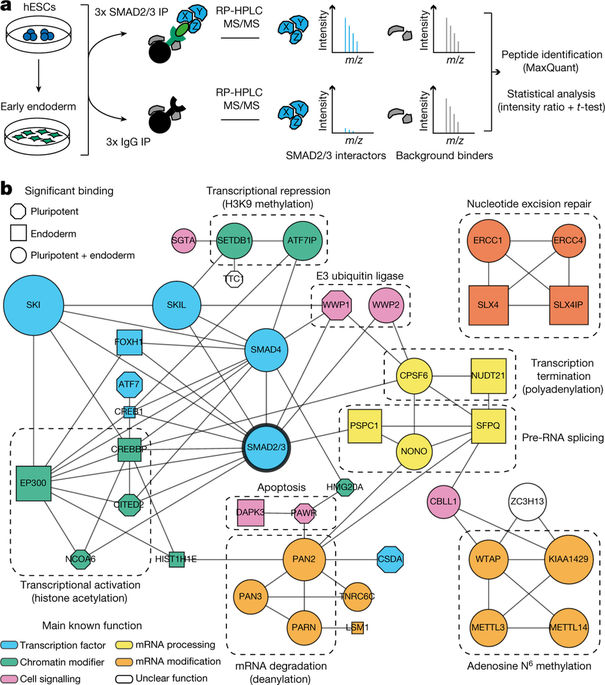Our official English website, www.x-mol.net, welcomes your
feedback! (Note: you will need to create a separate account there.)
The SMAD2/3 interactome reveals that TGFβ controls m6A mRNA methylation in pluripotency
Nature ( IF 50.5 ) Pub Date : 2018-02-28 , DOI: 10.1038/nature25784 Alessandro Bertero 1 , Stephanie Brown 1 , Pedro Madrigal 1, 2 , Anna Osnato 1 , Daniel Ortmann 1 , Loukia Yiangou 1 , Juned Kadiwala 1 , Nina C Hubner 3 , Igor Ruiz de Los Mozos 4 , Christoph Sadée 4 , An-Sofie Lenaerts 1 , Shota Nakanoh 1 , Rodrigo Grandy 1 , Edward Farnell 5 , Jernej Ule 4 , Hendrik G Stunnenberg 3 , Sasha Mendjan 1 , Ludovic Vallier 1, 2
Nature ( IF 50.5 ) Pub Date : 2018-02-28 , DOI: 10.1038/nature25784 Alessandro Bertero 1 , Stephanie Brown 1 , Pedro Madrigal 1, 2 , Anna Osnato 1 , Daniel Ortmann 1 , Loukia Yiangou 1 , Juned Kadiwala 1 , Nina C Hubner 3 , Igor Ruiz de Los Mozos 4 , Christoph Sadée 4 , An-Sofie Lenaerts 1 , Shota Nakanoh 1 , Rodrigo Grandy 1 , Edward Farnell 5 , Jernej Ule 4 , Hendrik G Stunnenberg 3 , Sasha Mendjan 1 , Ludovic Vallier 1, 2
Affiliation

|
The TGFβ pathway has essential roles in embryonic development, organ homeostasis, tissue repair and disease. These diverse effects are mediated through the intracellular effectors SMAD2 and SMAD3 (hereafter SMAD2/3), whose canonical function is to control the activity of target genes by interacting with transcriptional regulators. Therefore, a complete description of the factors that interact with SMAD2/3 in a given cell type would have broad implications for many areas of cell biology. Here we describe the interactome of SMAD2/3 in human pluripotent stem cells. This analysis reveals that SMAD2/3 is involved in multiple molecular processes in addition to its role in transcription. In particular, we identify a functional interaction with the METTL3–METTL14–WTAP complex, which mediates the conversion of adenosine to N6-methyladenosine (m6A) on RNA. We show that SMAD2/3 promotes binding of the m6A methyltransferase complex to a subset of transcripts involved in early cell fate decisions. This mechanism destabilizes specific SMAD2/3 transcriptional targets, including the pluripotency factor gene NANOG, priming them for rapid downregulation upon differentiation to enable timely exit from pluripotency. Collectively, these findings reveal the mechanism by which extracellular signalling can induce rapid cellular responses through regulation of the epitranscriptome. These aspects of TGFβ signalling could have far-reaching implications in many other cell types and in diseases such as cancer.
中文翻译:

SMAD2/3 相互作用组揭示 TGFβ 在多能性中控制 m6A mRNA 甲基化
TGFβ途径在胚胎发育、器官稳态、组织修复和疾病中具有重要作用。这些不同的作用是通过细胞内效应子 SMAD2 和 SMAD3(以下简称 SMAD2/3)介导的,其典型功能是通过与转录调节因子相互作用来控制靶基因的活性。因此,对给定细胞类型中与 SMAD2/3 相互作用的因素的完整描述将对细胞生物学的许多领域产生广泛的影响。在这里,我们描述了人类多能干细胞中 SMAD2/3 的相互作用组。该分析表明,SMAD2/3 除了在转录中的作用外,还涉及多个分子过程。特别是,我们确定了与 METTL3-METTL14-WTAP 复合物的功能相互作用,该复合物介导 RNA 上腺苷向 N6-甲基腺苷 (m6A) 的转化。我们显示 SMAD2/3 促进 m6A 甲基转移酶复合物与参与早期细胞命运决定的转录子子集的结合。这种机制使特定的 SMAD2/3 转录靶点不稳定,包括多能性因子基因 NANOG,使它们在分化后快速下调,从而能够及时退出多能性。总的来说,这些发现揭示了细胞外信号通过调节外转录组诱导快速细胞反应的机制。TGFβ信号传导的这些方面可能对许多其他细胞类型和癌症等疾病产生深远的影响。包括多能性因子基因NANOG,使它们在分化后快速下调,从而能够及时退出多能性。总的来说,这些发现揭示了细胞外信号通过调节外转录组诱导快速细胞反应的机制。TGFβ信号传导的这些方面可能对许多其他细胞类型和癌症等疾病产生深远的影响。包括多能性因子基因NANOG,使它们在分化后快速下调,从而能够及时退出多能性。总的来说,这些发现揭示了细胞外信号通过调节外转录组诱导快速细胞反应的机制。TGFβ信号传导的这些方面可能对许多其他细胞类型和癌症等疾病产生深远的影响。
更新日期:2018-02-28
中文翻译:

SMAD2/3 相互作用组揭示 TGFβ 在多能性中控制 m6A mRNA 甲基化
TGFβ途径在胚胎发育、器官稳态、组织修复和疾病中具有重要作用。这些不同的作用是通过细胞内效应子 SMAD2 和 SMAD3(以下简称 SMAD2/3)介导的,其典型功能是通过与转录调节因子相互作用来控制靶基因的活性。因此,对给定细胞类型中与 SMAD2/3 相互作用的因素的完整描述将对细胞生物学的许多领域产生广泛的影响。在这里,我们描述了人类多能干细胞中 SMAD2/3 的相互作用组。该分析表明,SMAD2/3 除了在转录中的作用外,还涉及多个分子过程。特别是,我们确定了与 METTL3-METTL14-WTAP 复合物的功能相互作用,该复合物介导 RNA 上腺苷向 N6-甲基腺苷 (m6A) 的转化。我们显示 SMAD2/3 促进 m6A 甲基转移酶复合物与参与早期细胞命运决定的转录子子集的结合。这种机制使特定的 SMAD2/3 转录靶点不稳定,包括多能性因子基因 NANOG,使它们在分化后快速下调,从而能够及时退出多能性。总的来说,这些发现揭示了细胞外信号通过调节外转录组诱导快速细胞反应的机制。TGFβ信号传导的这些方面可能对许多其他细胞类型和癌症等疾病产生深远的影响。包括多能性因子基因NANOG,使它们在分化后快速下调,从而能够及时退出多能性。总的来说,这些发现揭示了细胞外信号通过调节外转录组诱导快速细胞反应的机制。TGFβ信号传导的这些方面可能对许多其他细胞类型和癌症等疾病产生深远的影响。包括多能性因子基因NANOG,使它们在分化后快速下调,从而能够及时退出多能性。总的来说,这些发现揭示了细胞外信号通过调节外转录组诱导快速细胞反应的机制。TGFβ信号传导的这些方面可能对许多其他细胞类型和癌症等疾病产生深远的影响。











































 京公网安备 11010802027423号
京公网安备 11010802027423号